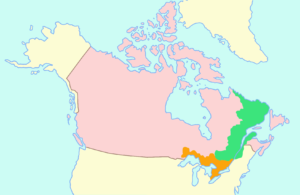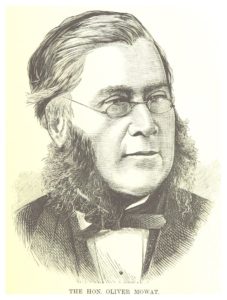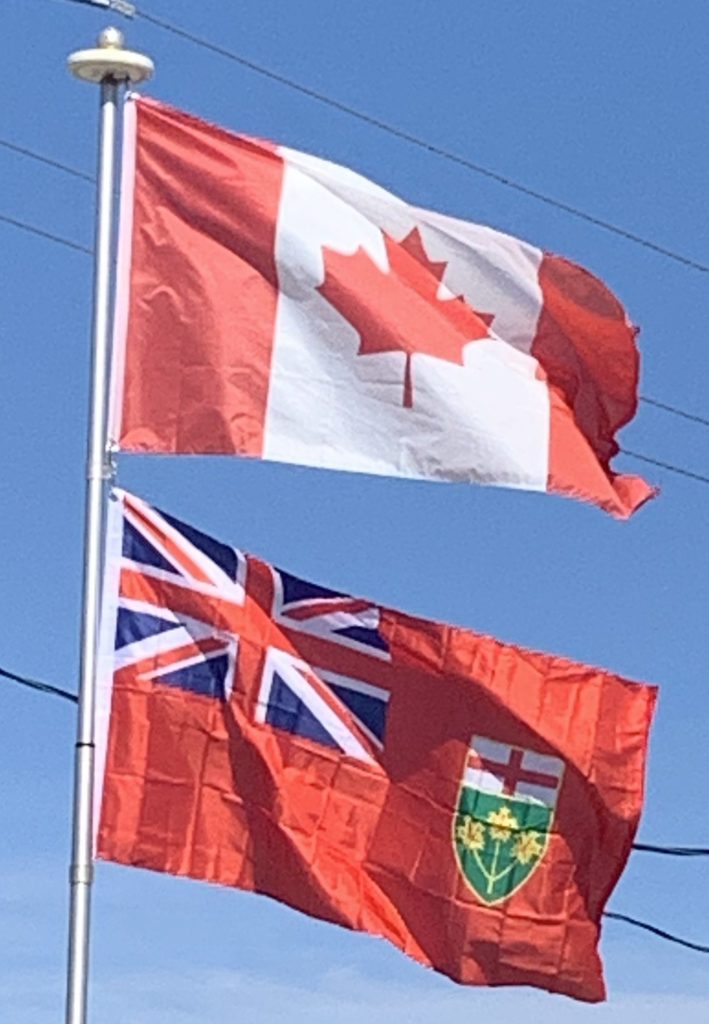
An economic boom in the 1850s coincided with railway expansion across the province, further increasing the economic strength of Central Canada. With the repeal of the Corn Laws and a reciprocity agreement in place with the United States, various industries such as timber, mining, farming and alcohol distilling benefited tremendously.
A political stalemate between the French– and English-speaking legislators, as well as fear of aggression from the United States during and immediately after the American Civil War, led the political elite to hold a series of conferences in the 1860s to effect a broader federal union of all British North American colonies. The British North America Act took effect on July 1, 1867, establishing the Dominion of Canada, initially with four provinces: Nova Scotia, New Brunswick, Quebec and Ontario. The Province of Canada was divided into Ontario and Quebec so that each linguistic group would have its own province. Both Quebec and Ontario were required by section 93 of the British North America Act to safeguard existing educational rights and privileges of Protestant and the Catholic minority. Thus, separate Catholic schools and school boards were permitted in Ontario. However, neither province had a constitutional requirement to protect its French- or English-speaking minority. Toronto was formally established as Ontario’s provincial capital.
Provincehood:
Once constituted as a province, Ontario proceeded to assert its economic and legislative power. In 1872, the lawyer Oliver Mowat became Premier of Ontario and remained as premier until 1896. He fought for provincial rights, weakening the power of the federal government in provincial matters, usually through well-argued appeals to the Judicial Committee of the Privy Council. His battles with the federal government greatly decentralized Canada, giving the provinces far more power than John A. Macdonald had intended. He consolidated and expanded Ontario’s educational and provincial institutions, created districts in Northern Ontario, and fought to ensure that those parts of Northwestern Ontario not historically part of Upper Canada (the vast areas north and west of the Lake Superior-Hudson Bay watershed, known as the District of Keewatin) would become part of Ontario, a victory embodied in the Canada (Ontario Boundary) Act, 1889. He also presided over the emergence of the province into the economic powerhouse of Canada. Mowat was the creator of what is often called Empire Ontario.

Beginning with Sir John A. Macdonald’s National Policy (1879) and the construction of the Canadian Pacific Railway (1875–1885) through Northern Ontario and the Canadian Prairies to British Columbia, Ontario manufacturing and industry flourished. However, population increase slowed after a large recession hit the province in 1893, thus slowing growth drastically but for only a few years. Many newly arrived immigrants and others moved west along the railway to the Prairie Provinces and British Columbia, sparsely settling Northern Ontario.
Mineral exploitation accelerated in the late 19th century, leading to the rise of important mining centers in the northeast, such as Sudbury, Cobalt and Timmins. The province harnessed its water power to generate hydro-electric power and created the state-controlled Hydro-Electric Power Commission of Ontario, later Ontario Hydro. The availability of cheap electric power further facilitated the development of industry. The Ford Motor Company of Canada was established in 1904. General Motors Canada was formed in 1918. The motor vehicle industry became the most lucrative industry for the Ontario economy during the 20th century.
